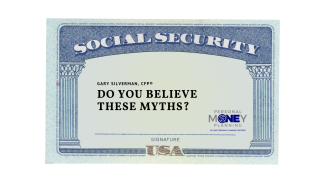
Do You Believe These Myths?
Given that a lot of the work I do for clients is helping them figure out how to fund their retirement, the subject of Social Security is an important aspect of the discussion. Part of that discussion looks at the amount of income the client will see in Social Security retirement benefits. A caveat within that discussion is the solvency issues of Social Security.
While I’ve mentioned this issue before, I’m going to go through it once again, because three big misperceptions keep coming up both in meetings and in posts I see on the Internet. I’ll look at each one in turn, but please realize that some of my answers are simplified rather than exhaustive.
Misconception #1: The money I’ve put into Social Security is my money. If I don’t get out at least what I’ve put in, the Government stole it from me.
Reality: You pay Social Security taxes. Since when do your taxes go into a savings account for you to draw from? Answer: Never. Same with Social Security. The taxes go to the government. What’s special about them is that they go into a pre-determined place for a pre-determined purpose. Most of the money is first used to supply current retirees with their monthly benefits. If there is any extra, it goes into the Social Security Trust Fund for future benefit payments. They’re not saving it just for you.
Misconception #2: The Social Security System is running out of money.
Reality: You may have heard that the system is going bankrupt. Whether that is true or not depends on how you want to define the term, but the important thing is the system is not running out of money. It can’t—at least not as long as people are working and paying into it. What will be running out of money is the Trust Fund.
When Social Security was set up the benefits were less than we have now and the ratio of workers to retirees was greater. Having fewer workers paying in and having each retiree drawing out increased benefits…well, you can see the imbalance. Because of that, we won’t have any extra leftover from Social Security taxes to feed into the Trust Fund, and that fund, as it was designed, will start paying out to help the ongoing taxes keep up with retiree needs.
At that point everything is fully funded--we’ll just be digging into saving to help fund it. However, the savings account (Trust Fund) will run out of money eventually. Last I saw, that happens in about 13 years give-or-take.
That’s not good, but it doesn’t mean payments will stop. The Social Security system will still be able to pay out most (estimates are in the 70-80% range) of the currently promised benefits if Congress does nothing to fix it.
Misconception #3: The government stole all (or most) of the money in the Trust fund, which is why the system is going bankrupt.
Reality: Sorry, not enough space to explain it this week. Come back next Sunday and I’ll explain.
Gary Silverman, CFP® is the founder of Personal Money Planning, LLC, a Wichita Falls retirement planning and investment management firm and author of Real World Investing.

